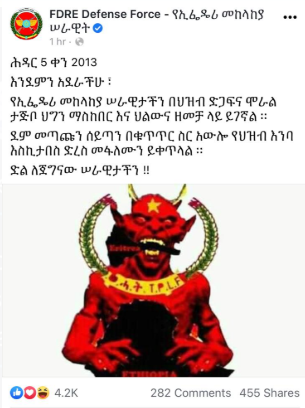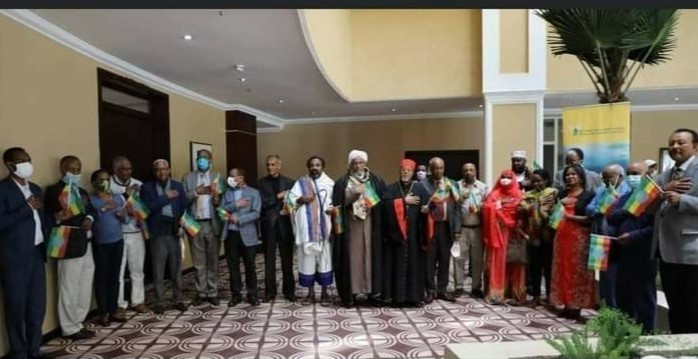Opinion
Religious Legitimization of Retributive Genocide: The Case of Tigray
Published
4 years agoon
By
TghatBy Theodros Assefa Teklu (Ph.D.)
The war waged by Ethiopia against Tigray exemplifies how religion legitimizes a retributive genocide. By retributive genocide, I mean the intentional massacre of people belonging to a politically or economically ‘dominant’ ethnic group or nation. In this article, I will offer my opinion on the religious legitimization of retributive genocide in Ethiopia, limiting my discussion to the war on Tigray.
As seen in the literature on genocide, religion can legitimize genocide in three ways:
- It can promote the othering of the group targeted for retributive genocide, constructing the Other as an essential enemy destined to be annihilated.
- It can justify exterminating the perceived enemy so that killing can be made without moral restraint and genocidal practice to be seen as a cosmic struggle between good and evil.
- Religion can authorize retributive genocide through authoritative texts and religious figures or ecclesiastic representatives, grounding retributive genocide in the divine mind or will.
In what follows, I will present the Tigrayan case as a religiously legitimized retributive genocide.
Othering
The othering of Tigray has a longstanding history. For the sake of brevity, let me limit my reflection to the most recent developments. The so-called political reforms that materialized in 2018 saw a shift in the dynamics of the then ruling coalition the Ethiopian People’s Revolutionary Democratic Party (EPRDF). Primarily one member of the coalition, the Tigray People’s Liberation Front (TPLF) was sidelined and ultimately dislodged in the process of transforming EPRDF into the now ruling Prosperity Party (PP). This process of political realignment was accompanied by the circulation of images of hostility that depict TPLF leaders and members as a collection of the most corrupt and evil personalities. This depiction was extended to Tigrayans in general in the popular imaginary through coordinated campaigns utilizing public speeches, documentaries on mainstream media, and social media posts all utilizing dehumanizing and othering labels.
Here, I wish to draw attention to three social groups in Ethiopia who have had a significant contribution to the othering of Tigrayans in Ethiopia. First, Protestant/evangelical Christians, historically marginalized and/or alienated in the Ethiopian public space, deeply welcomed the appointment of evangelical Abiy Ahmed as Prime Minister in 2018 and remain his strongest base with few outspoken exceptions. In relation to the war on Tigray, this group seems to also be motivated to support the federal assault for evangelical/missional purposes.
This mainly arises from the general belief that because Tigray is portrayed as an Orthodox stronghold it is anti-Gospel whose inhabitants can efficiently serve as agents of the devil. As a result, the occupation of Mekelle by the Ethiopian Defense Forces was seen as an opportunity that would open up Tigray for the Gospel. Following that and even when the gruesome atrocities committed by Ethiopian and allied forces in Tigray were revealed many protestants, including the Prime Minister himself, continued to depict the ongoing conflict in terms of a holy war; good vs evil.
Second, within the context of the Ethiopian Orthodox Church, longstanding rivalries within the ecclesiastical hierarchy of the church made it easy to support the war efforts of the federal government. Such ecclesial feud seems to be one of the motivations for othering Tigrayans (as was the case in Rwanda). Both the late Patriarch Abune Paulos and his successor Abune Mathias I, are Tigrayans. The controversy between the diaspora-based Patriarch Abune Merkorios and his co-Patriarchate with Patriarch Mathias reveals the ethnic othering of Tigrayans.
Third, secular elites deployed quasi-religious ideas. For example, the PM repeatedly interprets the nativity narrative of the gospels in light of contemporary political differences and the ongoing conflict in the country. In one instance, for example, he used the gospel to explain political differences between his newly (illegally) established Prosperity Party (PP) and the TPLF. Accordingly, he depicted the latter as Herodians determined to kill the Messiah, in this case representing the newly born party. The intended moral of the story is that the Herodians (TPLF) will destroy young lives with the view of eliminating PP, but at the same time, PP must be determined to fight against the Herodians by all means.
In another context, he referenced the episode of Jesus in the boat with his disciples to castigate people for not trusting in his leadership in the war. He depicts himself as the supernaturally empowered messiah figure, the people listening to him as the faithless disciples, and the war (along with those on the other side) as malevolent forces represented by the storm.
The analysis also reveals a consistent stream of hate speech and labelings – such as yeqen jib (daylight hyena) and junta, terrorist, satans, and monsters – given to Tigrayans high-level Ethiopian officials, influential figures, and social media commentators. This dehumanizing campaign was not opposed by religious people – instead, such language and labels have been deployed and reiterated by religious leaders.
Justification
The genocidal practices of Ethiopia have also been justified with religious and quasi-religious ideas, which promoted delusional beliefs that underpin the extermination of Tigrayans. The war against Tigray is warranted as a cosmic struggle (gädil) between good and evil. Such justification is a twofold justification of the incumbent government as an instrument of good and Tigrayans as embodiments of evil. Firstly, the rise of PM Abiy to power has been understood by Christians as ‘an answer to prayer’ affirming the event as ‘divine intervention.’
Secondly, the justification of the goodness of the present government with all its loyal citizens is simultaneously a justification that all ‘bad subjects’ are instruments of evil. Right at the beginning of the war, the Ethiopian National Defense Forces (ENDF) webpage uploaded the logo of the TPLF, adding a portrayal of the devil.

Such dehumanization has extended to all Tigrayans who have been represented as the evil enemies of the country and its messianic ruling party (the PP). An advisor to the PM, Deacon Daniel Kibret, amplified the depiction of Tigrayans as ‘monsters’ and ‘satans’ whom Ethiopians must efface from the land without leaving any memory of them for future generations. The rhetoric does not simply equate the evil of Tigrayans with that of satan, but a deep hatred that justifies the genocidal practices enacted on Tigrayans. An Orthodox priest presented the evil of Tigrayans as surpassing that of satan and declared that Ethiopians prefer the rule of Satan over that of Tigrayans.
Thus, the destiny of Tigrayans must be, according to this rhetoric, ‘hell’.
The religious justification for the deservedness of the genocidal practices of the Ethiopian state has been framed by the retributive worldview of Christians. The retribution is considered in light of sowing and reaping; Tigrayans are reaping the evil seeds they sowed in the past, particularly the oft referred to 27 years of darkness under TPLF-EPRDF governance of Ethiopia. The contrast between light and dark is primarily understood within the frames of religious discourse.
The cultural notion of gif (the retribution or judgment for past acts of injustice) also plays a role here. This notion is used to argue that Tigrayans are subjected to a deserved suffering and justifies that Ethiopians can exterminate them and cleanse (and make) themselves to be sanctified. This is more directly articulated in a statement by well-known political personality and artist Debebe Eshetu who counseled:
…instead of being eaten by a hyena, it is better to eat the hyena and repent, my advice to Dr. Abiy is to let’s eat them and repent.
Debebe Eshetu
Authorization
After the Ethiopian state declared the enforcement of the rule of law following the alleged TPLF’s ‘preemptive attack’ on the Northern Command as a pretext for the war against Tigray, religious authorization of war was sought to mobilize Ethiopians who are mainly religious. ESAT – a diaspora-based TV broadcast – had declared, years before the war, that the battle was between 95 million Ethiopians and 5 million minority Tigrayans. This incitement to violence against an ethnic minority was supported by the horrendous justification that it is essential to drain the ‘sea’ (Tigrayan people) to kill the ‘fish’ (TPLF leaders). This framework has implicitly and explicitly framed the authorization given to the war waged against Tigray.
Further authorization was given by religious leaders and teachers grounding the war in divine will/mind based on sacred texts and prophetic utterances.

Such solidarity was expressed through publicly expressed support and generous financial support made to the Ethiopian National Defense Forces. This alienation of Tigrayans from religious institutions was also underscored by preachings from church pulpits and in media commentary from all traditions. In the evangelical context, prophetic utterances attesting that the war was the will of God were cited. In these utterances, Tigray is characterized as being doomed for destruction and the rest of Ethiopia destined for blessing and prosperity in the aftermath of the conflict. Religious rhetoric from other groups, particularly the Orthodox, resonated with the doomsday-type framing of the evangelical prophets, etc. In the Islamic tradition, the prophecies of Sheik Gabriel/Jibril were said to have portended and legitimized the war against Tigray.
In conclusion, one may ask if religion could also serve as a bulwark against genocide. Although many religious adherents support the genocidal war on Tigray, few religious voices condemn such evil practice. A notable example in this regard has been His Holiness Abune Mathias I, Patriarch of the Ethiopian Orthodox Church who decried the ongoing genocide war in spite of the various efforts to politicize and suppress his voice because of his Tigrayan identity. A few other Protestant teachers – the likes of Mariamawit Hana Haile and Pastor Edmond Berhane– actively oppose the genocide using religious discourse as the basis of their counter-narratives. These voices have, however, sadly been met with either opposition or indifference.

Esayas G
March 16, 2022 at 3:58 am
Great analysis and explanation to the genesis of the Tigray Genocide. The Ethiopian religious leaders (Protestant, Muslim, Orthodox, etc) acted not just from religion stand point but the ethnicity of each leader was an exponential factor in that. They not only were oblivious to the horrific consequences of the ‘Law enforcement’ measures of Abiy Ahmed’s brutal war on Tigray, but in full support:! Has anything changed since? Have they regretted their inaction and passive support of the TigrayGenocide?. No!! I tell you, they will open handedly accept an offer to reduce the price of cooking oil by 100 ETB /litre in exchange for total annihilation of Tigray!! One prominent Horn political analyst once said, ‘ the greatest tragedy is not the TigrayGenocide, but the loss of empathy among the ethnicities in Ethiopia’! Doesn’t this mean that TigrayGenocide was not the beginning of Ethiopian prosperity but rather the beginning of the end of Ethiopian empire, the empire built in the foundations of receipt, killings, massacres, mass tapes, looting and destruction , throughout its history, except some respite it had at some point. Hoping for a peaceful disintegration for everyone!
Negasi Awetehey Nega
April 5, 2022 at 1:08 pm
great analysis religious leaders have role of sanctifying genocide